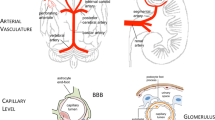Access this chapter
Tax calculation will be finalised at checkout
Purchases are for personal use only
Similar content being viewed by others
References
Aerts JM, Groener JE, Kuiper S et al (2008) Elevated globotriaosylsphingosine is a hallmark of Fabry disease. Proc Natl Acad Sci USA 105(8):2812–2817
Altarescu G, Chicco G, Whybra C et al (2008) Correlation between interleukin-6 promoter and C-reactive protein (CRP) polymorphisms and CRP levels with the Mainz Severity Score Index for Fabry disease. J Inherit Metab Dis 31(1):117–123
Baptista MV, Ferreira S, Pinho EMT et al (2010) Mutations of the GLA gene in young patients with stroke: the PORTYSTROKE study–screening genetic conditions in Portuguese young stroke patients. Stroke 41(3):431–436
Beck M (2006) Demographics of FOS – the Fabry Outcome Survey. In: Beck M, Mehta A, Sunder-Plassmann G (eds) Fabry disease: perspectives from 5 years of FOS. Oxford PharmaGenesis, Oxford
Brouns R, Thijs V, Eyskens F et al (2010) Belgian Fabry study: prevalence of Fabry disease in a cohort of 1000 young patients with cerebrovascular disease. Stroke 41(5):863–868
Chamorro A, Vila N, Ascaso C et al (1995) Early prediction of stroke severity. Role of the erythrocyte sedimentation rate. Stroke 26(4):573–576
Demuth K, Germain DP (2002) Endothelial markers and homocysteine in patients with classic Fabry disease. Acta Paediatr Suppl 91(439):57–61
Fedi S, Gensini F, Gori AM et al (2005) Homocysteine and tissue factor pathway inhibitor levels in patients with Fabry's disease. J Thromb Haemost 3(9):2117–2119
Friedman AN, Bostom AG, Selhub J et al (2001) The kidney and homocysteine metabolism. J Am Soc Nephrol 12(10):2181–2189
Ginsberg L, Manara R, Valentine AR et al (2006) Magnetic resonance imaging changes in Fabry disease. Acta Paediatr Suppl 95(451):57–62
Hankey GJ, Eikelboom JW (2005) Homocysteine and stroke. Lancet 365(9455):194–196
Lee M, Hong KS, Chang SC et al (2010) Efficacy of homocysteine-lowering therapy with folic Acid in stroke prevention: a meta-analysis. Stroke 41(6):1205–1212
Mehta A, Ginsberg L (2005) Natural history of the cerebrovascular complications of Fabry disease. Acta Paediatr Suppl 94(447):24–27, discussion 29–10
Mehta A, Beck M, Eyskens F et al (2010) Fabry disease: a review of current management strategies. QJM 103(9):641–659
Miller ER 3rd, Juraschek S, Pastor-Barriuso R et al (2010) Meta-analysis of folic acid supplementation trials on risk of cardiovascular disease and risk interaction with baseline homocysteine levels. Am J Cardiol 106(4):517–527
Moore DF, Altarescu G, Barker WC et al (2003) White matter lesions in Fabry disease occur in 'prior' selectively hypometabolic and hyperperfused brain regions. Brain Res Bull 62(3):231–240
Rolfs A, Bottcher T, Zschiesche M et al (2005) Prevalence of Fabry disease in patients with cryptogenic stroke: a prospective study. Lancet 366(9499):1794–1796
Shu L, Park JL, Byun J et al (2009) Decreased nitric oxide bioavailability in a mouse model of Fabry disease. J Am Soc Nephrol 20(9):1975–1985
Swartz JE, Jacobson BF, Connor MD et al (2005) Erythrocyte sedimentation rate as a marker of inflammation and ongoing coagulation in stroke and transient ischaemic attack. S Afr Med J 95(8):607–612
Testai FD, Gorelick PB (2010) Inherited metabolic disorders and stroke part 1: Fabry disease and mitochondrial myopathy, encephalopathy, lactic acidosis, and strokelike episodes. Arch Neurol 67(1):19–24
Vedder AC, Biro E, Aerts JM et al (2009) Plasma markers of coagulation and endothelial activation in Fabry disease: impact of renal impairment. Nephrol Dial Transplant 24(10):3074–3081
Wozniak MA, Kittner SJ, Tuhrim S et al (2010) Frequency of unrecognized Fabry disease among young European-American and African-American men with first ischemic stroke. Stroke 41(1):78–81
Author information
Authors and Affiliations
Corresponding author
Editor information
Editors and Affiliations
Additional information
Communicated by: Verena Peters
Appendices
Author Contributions
Ron Cheung . Wrote the initial draft article and performed statistical analyses.
David Sillence. Revised the draft article and supervised enzyme replacement therapy.
Michel Tchan. Designed the study and revised the draft article. Supervised enzyme replacement therapy. Guarantor.
Competing Interest Statement
Dr Tchan reports having received reimbursement from Genzyme Corporation for travel expenses to attend educational meetings.
Details of Funding
No funding was obtained for this study.
Ethics Approval and Patient Consent
Ethics approval was obtained from the human research ethics committee of the Children’s Hospital at Westmead (project MR 2009-06-15). Written, informed consent was taken from all participants.
Synopsis
Elevated homocysteine concentrations and ESR are independent risk factors for CVD in Fabry disease.
Rights and permissions
Copyright information
© 2012 SSIEM and Springer-Verlag Berlin Heidelberg
About this chapter
Cite this chapter
Cheung, R., Sillence, D.O., Tchan, M.C. (2012). Homocysteine and Erythrocyte Sedimentation Rate Correlate with Cerebrovascular Disease in Fabry Disease. In: JIMD Reports - Case and Research Reports, 2012/3. JIMD Reports, vol 6. Springer, Berlin, Heidelberg. https://doi.org/10.1007/8904_2011_123
Download citation
DOI: https://doi.org/10.1007/8904_2011_123
Received:
Revised:
Accepted:
Published:
Publisher Name: Springer, Berlin, Heidelberg
Print ISBN: 978-3-642-28128-0
Online ISBN: 978-3-642-28129-7
eBook Packages: MedicineMedicine (R0)




